6 December, 2004
Is it true there were dinosaurs in Antarctica?
Yes, it is true! Paleontologists study rocks for fossils of ancient plants and animals. They have made several discoveries including dinosaurs, plants, and other kinds of animals that lived in Antarctica was located close to the equator millions of years ago.
One of the first dinosaur fossils discovered in Antarctica was right here on Ross Island. That is because Ross Island is one of the few places in Antarctica where some of the land is not covered by deep snow and ice all year. Fossils of over 800 species of animals have also been found on Seymour Island, off the tip of the Antarctic Peninsula and range from 40 to 120 million years old. One of them was a penguin-like bird that stood five feet tall and weighed about 200 pounds! And, an armadillo-looking creature lived there that was about the size of a Volkswagen car! One interesting animal that lived here was the Lystrosaurus, which is believed to be a mammal-like reptile, not a dinosaur. Not too long ago, the dinosaur cryolophosaurus, a large meat-eater that resembles a tyrannosaurus, was discovered in the mountains not far from the South Pole.
Fossils of dinosaurs and plants have been used as evidence of the existence of Gondwanaland and the continental drift theory. According to the theory, the land that is now Antarctica was close to the equator about 500 million years ago when it was part of the super-continent, Pangaea. Fossils show that at that time there were rainforests here; scientists have found stands of tree stumps that are 2-feet in diameter. Pangaea floated on the more liquid interior layers of the Earth, and by 250 million years ago the land that is Antarctica had drifted pretty south. About 200 million years ago, Pangaea broke into two large pieces of land, Laurasia in the north and Gondwanaland in the south. Eventually Gondwanaland also broke up and drifted apart, creating the continents of Antarctica, Australia, Africa, and South America.
What I think is interesting is that many of the fossils found in Antarctica are believed to be from a period when it was already pretty close to the South Pole. That tells us that the Earth's climate was a lot different back then because those plants and animals could not have survived in a cold climate like we have in Antarctica now. It was not until about 40 million years ago that Earth started to cool down and ice appeared in Antarctica. Before that, the world was a very warm place.
Kristen Hutchinson, a writer for our local newspaper, the Antarctic Sun, included the following in the November 10, 2002 issue. If you want to read more about dinosaurs in Antarctica, her arcticle provides a very good introduction for some research of your own: <http://www.polar.org/antsun/oldissues2002-2003/Sun111002/dinosaurs.html>
Ankylosaur
Heavily armored, tank-like plant eating dinosaurs. They ate low-lying plants, such as ferns, shorter cycads and moss. It was found on Ross Island.
Cryolophosaur
The only carnivorous dinosaur found in Antarctica to walk semi-upright on its back legs. Its name means frozen-crested lizard, for the cold region where it was found and the characteristic crest on the top of its skull, above the eyes. It was about 22 feet (7 meters) long. A cryolophososaurus skeleton was found in the Transantarctic Mountains.
Hadrosaur
Duck-billed herbivores with horny beaks. They ran on two legs, but may have walked on all four while grazing. They probably lived near bodies of water.
Hypsilophodontid
Meaning "high-crested tooth," these were a group of small, gazelle-like, herbivorous, large-eyed, long-legged, five-fingered, four-toed, herding dinosaurs. Hypsilophondontids had no natural defenses from predators except their speed, senses and small claws on their toes. Usually up to 10 feet (3 meters) long, an unusually long one, 13 to 16 feet (4 to 5 meters) long, was found on Vega Island.
Plateosaurid prosauropod
Herbivores with long necks and tails, walking on either two or four legs. Its bottom jaw attached well below the level of its teeth. They ranged in size from about 10 to 33 feet (3 to 10 meters). It was found being eaten by the cryolophosaurus in the Transantarctic Mountains.
Lystrosaurus
The "shovel lizard" was a heavily-built, mammal-like reptile, with a stubby tail. Instead of teeth it had two tusk-like fangs made of horn. It was a plant-eater about 3 feet (1 meter) long that lived in herds near lakes and swamps.
Mosasaur
A carnivorous marine reptile with 4-inch (10 cm.) long teeth and a "duck-bill." They were up to 33 feet (10 meters) long and had 3-foot (1 meter) long skulls. The lower jaw could unhinge to eat things larger than their own heads. They were not dinosaurs, but were related to snakes and monitor lizards.
Plesiosaur
Flippered marine reptiles, with long, snake-like necks, tiny heads and wide bodies. They were not dinosaurs, but ranged in size from 8 to 46 feet (2 to 14 meter) long. They lived in the open ocean and breathed air. Plesiosaurs remains were found on Vega Island on the Antarctic Peninsula.
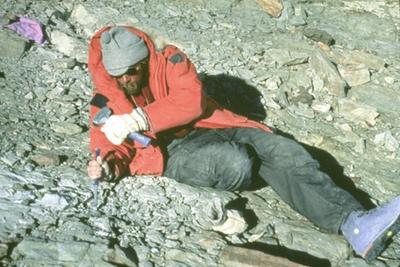
1: Paleontologists search for clues to Antarctica's past in plant and animal fossils (photo NSF)

2: Paleontologist Bill Hammer discovered cryolophosaurus fossils in Antarctica; here he holds a fossil he believes to be a sauropod. (Photo NSF)

3: Model of a large carniverous cryolophosaur found near the South Pole
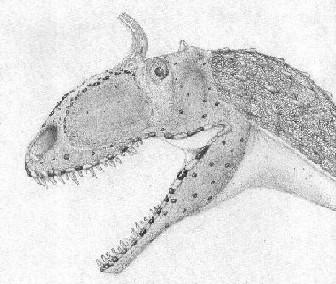
4: Drawing of a cryolophosaurus head by Samuel Barnet

5: Lystrosaurus was a mammal-like reptile, not a dinosaur.
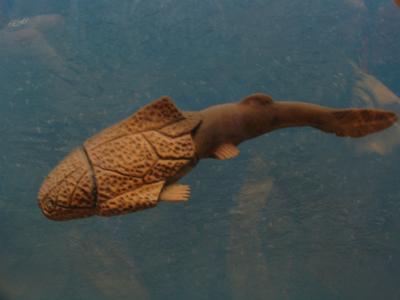
6: Fish fossils show that placoderms once lived in Antarctic waters.

7: One of many pertrified tree stumps found in Antarctica

8: Fern fossil from Antarctica's ancient rainforest
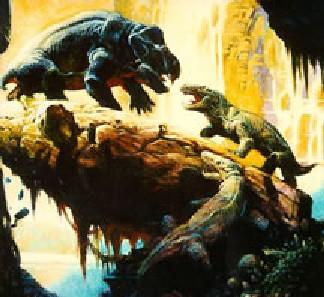
9: Moasaurus was a marine reptile not a dinosaur; they were related to snakes and monitor lizards. (drawing by Dan Varner)
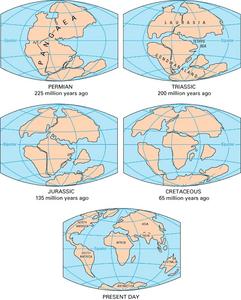
10: The continental drift theory explains how these plants and animals lived in Antarctica millions of years ago.
Contact the TEA in the field at
.
If you cannot connect through your browser, copy the
TEA's e-mail address in the "To:" line of
your favorite e-mail package.
|
